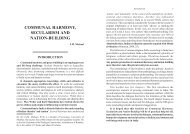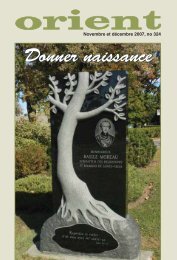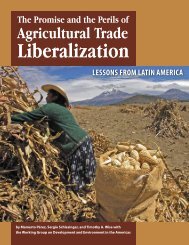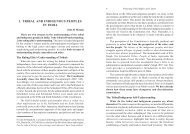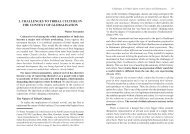DALIT ASSERTION IN NORTH INDIA A View from Below
DALIT ASSERTION IN NORTH INDIA A View from Below
DALIT ASSERTION IN NORTH INDIA A View from Below
You also want an ePaper? Increase the reach of your titles
YUMPU automatically turns print PDFs into web optimized ePapers that Google loves.
122 Integral Liberation Vol. 8, No. 2 June 2004<br />
<strong>DALIT</strong> <strong>ASSERTION</strong> <strong>IN</strong> <strong>NORTH</strong> <strong>IN</strong>DIA<br />
A <strong>View</strong> <strong>from</strong> <strong>Below</strong><br />
Prakash Louis<br />
Dalit Assertion<br />
Dalit 1 assertion, liberation and emancipation are themes that<br />
have come to the centre-stage of the current sociological<br />
discourse. 2 With the emergence of Dalit assertion, the social scientists<br />
are forced to take note of caste discrimination. The human rights<br />
activists are also directed to look at the specificity of Dalit rights<br />
while engaging themselves in rights issues in general. In common<br />
parlance, to assert is to declare positively, lay claim to, insist upon<br />
and affirm. In the same vein, assertion is defined as ‘the act of claiming<br />
one’s rights’ or ‘a positive statement about oneself or one’s intent’. 3<br />
Thus, assertion could be defined as a positive declaration about<br />
oneself, one’s past, present and future. While spelling out one’s<br />
resolve to determine one’s course of action, this assertion also informs<br />
the others of this resolve. It is here that Dalit assertion confronts<br />
resistance and repression <strong>from</strong> the dominant castes and classes and<br />
their agent, the state. Yet, it is this cumulative effort to build an identity<br />
of their own which provides the space and scope for a long drawnout<br />
struggle for emancipation.<br />
Exclusion, discrimination and marginalisation which emerge out<br />
of the caste system in general and untouchability in particular have<br />
been the historical and societal lot of the Dalits. It is also a fact that<br />
socio-religious reforms, participation in electoral politics, poverty<br />
alleviation programmes and special welfare schemes and even<br />
affirmative action did not have the expected impact on the evil<br />
practices of the caste system and untouchability. While exploitation<br />
and oppression of the Dalits have become the order of the day,<br />
Dr. Prakash Louis is the Executive Director of the Indian Social Institute, 10<br />
Institutional Area, Lodi Road, New Delhi 110 003; Tel.: (011) 24625015,<br />
24622370; Email: prakash@unv.ernet.in, prakashlouis@hotmail.com;<br />
Website: www.isidelhi.org<br />
one should also take note of the anger and the assertion that is<br />
becoming a fact of Dalit society today. A clear case of this Dalit<br />
anger and assertion was witnessed in Mumbai on July 11 th , 1997. 4<br />
The vandalisation of the statue of Dr. Bhimrao Ambedkar in Ramabai<br />
Ambedkar Nagar sparked off violent protests and revolts by the Dalits.<br />
This led to police firing in which about 11 people were killed.<br />
Interestingly, this is not the first instance of desecration of a statue<br />
of Dr. Ambedkar in Maharashtra. It is estimated that in the last 5<br />
years about 508 such incidents have been reported. 5 But the social<br />
fact which needs to be noted is that these incidents led to revolt, and<br />
this time the nature of the agitation was more violent and widespread.<br />
This incident immediately provoked reactions, not only in<br />
Maharashtra but also in Gujarat where the Bharatiya Dalit Panthers<br />
gave a call for a bandh. Over the years, many reforms and revolts<br />
have given a specific identity to the Dalits and have established their<br />
assertion on the Indian scene.<br />
Some specific socio-political, economic and cultural factors<br />
provide the space and scope for Dalit assertion. Eleanor Zelliot, in<br />
her perceptive analysis of Dr. Ambedkar’s central relevance to Dalit<br />
assertion, explains that Dr. Ambedkar’s position among Dalits can<br />
be equated with that of a guru, one who leads his disciples to develop<br />
their own identity and wisdom. Dr. Ambedkar’s stance against all<br />
that he saw as evil, as harmful to the lowly and hence to the country,<br />
is a source of mobilisation. Further, Dr. Ambedkar stands tall as a<br />
symbol of achievement. Eleanor goes on to explain that Dr.<br />
Ambedkar’s legend can be seen in contrasting his image to that of<br />
Gandhi. Dalits have been extraordinarily hostile to Gandhi, who is<br />
seen by many non-Dalits as the political leader more responsible for<br />
bringing the concern about the problems of untouchables to the<br />
consciousness of India. The reason is that Gandhi’s ‘Harijan’ is an<br />
object of pity; compassion also, but mainly pity. Ambedkar’s Dalit is<br />
a man or woman filled with pride and self-respect. Social movements<br />
thrive on pride. The multi-faceted Dr. Ambedkar stands for both<br />
qualities: pride and self-respect. 6<br />
The demand by the Ad-Dhramis or the Dalits or the erstwhile<br />
untouchable castes for representation in the Management Committee<br />
of the Baba Nihal Singh Smadh-Gurudwara in Talhan village in
Dalit Assertion in North India 123 124 Integral Liberation Vol. 8, No. 2 June 2004<br />
Punjab highlights the many paths the Dalits have trodden to attain<br />
their social consciousness, better caste consciousness and the<br />
concurrent move to establish their rightful place and role in Indian<br />
society and polity. The incidents which unfolded in Talhan <strong>from</strong><br />
January to June 2003 reveal the nature of caste relations in Punjab.<br />
They also provide us with a good idea of the growing aspirations of<br />
the Dalits. The demand by the Dalits for representation in the<br />
Management Committee is not just a demand for an equal share in<br />
the cake but it is an indication of Dalit assertion for equality and<br />
equal rights. It questions the age-old assumption that the landowning<br />
dominant castes of Jats have the right to the exclusive control over<br />
the economy and socio-cultural resources of the village. It has also<br />
highlighted their resolve to determine their course of action in dayto-day<br />
life as well as in crisis situations. Hence, change in the caste<br />
system is in the offing in rural Punjab.<br />
The Dalit assertion in Talhan like in many parts of the country<br />
has moreover exposed the political parties and the limited scope of<br />
their electoral politics for not only Dalit emancipation but for<br />
restructuring the Indian social order. Identity formation of the Dalits<br />
has been going on unabated and the recent Dalit assertions in various<br />
parts of India have once again provided scope and space for the<br />
discourse on restructuring the Indian social order. The social<br />
scientists, political activists and human rights activists are called<br />
upon to pay serious attention to the emerging Dalit assertion for<br />
emancipation. 7<br />
Dalit Identity Formation<br />
Identity formation is a universal and historical process, 8 which<br />
is based on the experience about oneself and the experience in relation<br />
to others. This experience does not take place in a vacuum but in the<br />
existing socio-economic, political and cultural milieu. It can thus be<br />
stated that identity formation is an interactional process.<br />
Based on an empirical study, Dr. Fernando Franco argues that to<br />
deal with the issue of a group’s identity is to be engaged in the<br />
analysis of a group’s process of becoming. There are two<br />
interrelated components in this process of identity formation. The<br />
first one is the ideological-symbolic component. This refers to the<br />
system of beliefs and practices which flow <strong>from</strong> the understanding<br />
of the position of oneself and one’s own group vis-à-vis others. This<br />
set of beliefs and its various cultural expressions provide the group<br />
with a shared meaning and understanding about who they are and<br />
what their role is in a given social context. The second is the materialproductive<br />
component, which refers to the material, ecological and<br />
economic conditions shaping and determining the primary livelihood<br />
activities of the group and its productive relations with others. In<br />
other words, it includes the factors which determine the economic<br />
life of the group and consequently the relationships its members enter<br />
into with each other and with other groups in the course of earning<br />
their livelihood. 9<br />
The emerging Dalit identity, especially after Independence,<br />
is multi-faceted. Significantly, the term ‘Dalit’ itself is indicative of<br />
the revolutionary progression made within the Dalit community visà-vis<br />
the non-Dalits. To begin with, one should realise the power of<br />
the concept ‘Dalit’ which denotes the assertion of the erstwhile<br />
‘untouchables’ that they are the outcastes, achuts, that is, the<br />
untouchables, the excluded segment of the Indian population. In<br />
extension it is also asserting, “we are a broken people”, “we are people<br />
crushed by oppression and exploitation”. While this sense of<br />
affirmation is only the starting-point, the sense of negation is the<br />
culminating factor. This can be framed as a collective monologue of<br />
resistance: “Yes, we were the broken people, we were crushed, but<br />
now we will not allow ourselves to be broken or crushed by you. We<br />
will not allow you – the dominant castes – to break us or crush us<br />
any more.”<br />
Revising the earlier positions upheld by social scientists, some<br />
of the recent works have become tired of highlighting the salient<br />
features of the emerging Dalit identity. However, the identity of the<br />
Dalits was truly formed in relation to the dominant castes. But this<br />
does not mean all inquiries stop there. The dominant castes were and<br />
continue to be the feudal landlords, headmen of the village<br />
panchayats, moneylenders and the ‘representatives of the state<br />
apparatus’. The Dalits on the other hand were and still are the landless<br />
agricultural labourers, the illiterate bonded labourers and outcastes,<br />
and the ‘beneficiaries’ or those at the receiving end of the welfare<br />
schemes of the state. In this heinously unequal and undemocratic<br />
socio-political milieu where the dominant castes constantly and
Dalit Assertion in North India 125 126 Integral Liberation Vol. 8, No. 2 June 2004<br />
continuously enforced subjugation, domination and dehumanisation,<br />
the Dalits developed a sense of being second-grade citizens.<br />
Though the Dalits were victimised by the process of bondage<br />
and servitude, they continued to protest and resist every form of<br />
oppression. Especially with the enactment of constitutional rights<br />
and privileges, the Dalits began to demand equality of rights for all.<br />
This has further enhanced the political consciousness of the Dalits.<br />
The social ostracism, economic deprivation, political marginalisation<br />
and cultural subjugation the Dalits suffered have augmented and<br />
expanded their resolve to counter all forms of discrimination. It is<br />
this eruption of Dalit determination which has shaken the<br />
‘untouchable and unalterable’ caste edifice. It is not argued here<br />
that the Dalits have attained total liberation or that they are very near<br />
to achieving emancipation. But it is an undeniable truth that the Dalits<br />
have made great strides in terms of forging a long drawn-out struggle<br />
against the caste system and caste discrimination.<br />
The discourse analysis that ensued opened up an array of options<br />
for the social scientists to interpret the emerging Dalit identity. But<br />
for the Dalits, it has become clear like daylight that the Dalits as<br />
individuals and as a collectivity have become politically conscious<br />
and that their social awareness is on the ascent. One can also discern<br />
a confident behaviour pattern among the Dalits. But this assertion<br />
had to encounter the repressive measures of the dominant castes as<br />
well as the state, which often functions as their agent. The findings<br />
of many research studies about the response of the Dalits to repression<br />
have pointed to two interconnected realities. In some cases, the Dalits<br />
and their organisations submitted to the repressive operations of the<br />
dominant castes and the state. In many other cases, the attempt to<br />
stifle the organisational and mobilisational efforts of the Dalits was<br />
countered by much broader and long drawn-out struggles.<br />
Upholding the dignity of their women is one arena where the<br />
Dalits have shown formidable determination and power.<br />
Compared to Dalit men, Dalit women suffer <strong>from</strong> the triple<br />
discrimination of caste, class and gender. Hence, initiating change in<br />
their social condition was a concurrent aspect of Dalit assertion and<br />
Dalit movements. But this is once again only a partial script of the<br />
emerging Dalit identity. Over the years, the Dalit women themselves<br />
have constructed an identity about their lives and struggles. This<br />
identity deals with their multiple roles and problems as individuals,<br />
in the family, at workplaces, in the religious sphere and in the Dalit<br />
and wider society. There is every indication that Dalit women are<br />
taking many strides to liberate themselves <strong>from</strong> innumerable clutches.<br />
But the central and crucial aspect of this liberation is that they are<br />
envisioning their emancipation within the context of both their<br />
concrete deprivations and possibilities.<br />
It is moreover significant to note that at the local, regional and<br />
national levels, the economic condition of the Dalits has not improved<br />
despite scores of developmental schemes. Almost all the Dalits lack<br />
access to or ownership over resources, and control over their labour,<br />
employment, wages, etc. This enforces upon them the necessity to<br />
depend upon the dominant castes, who in turn exploit them. It is this<br />
economic dependence which inhibits every resolve of the Dalits to<br />
fight against the dominant castes.<br />
At this juncture it is expedient to underscore the social fact that a<br />
perceptive comprehension of the consequences of untouchability and<br />
atrocities has become part of the Dalit discourse. This is due to the<br />
socio-political mobilisation of the Dalits. But it would be foolhardy<br />
to claim that this awareness has been evenly spread throughout the<br />
Dalit community, or that every Dalit perceives his or her oppression<br />
and has empowered oneself to resist these onslaughts. But what is<br />
argued here is that this is the general trend among the Dalits. If this<br />
trend continues, it will not be too long before the Dalits engage in an<br />
extended struggle for the total restructuring of the Indian social order.<br />
Finally, it needs to be stated here that the identity formation among<br />
the Dalits followed various alternative processes in different states<br />
and within a state. This is due to the nature of the social milieu, the<br />
counteracting forces, the level of Dalit mobilisation and organisation,<br />
the social mobility that has been possible in the given historical<br />
context, the centrality of Dr. Ambedkar and the strategy followed. In<br />
the given productive relations, the ideological and material-productive<br />
components have contributed to the emergence of Dalit identity. Only<br />
time will reveal which direction identity formation will take in the<br />
future. But it is a fact that anti-caste movements and Dalit struggles<br />
have come to stay. It is they who will alter the very structure of<br />
Indian society.
Dalit Assertion in North India 127 128 Integral Liberation Vol. 8, No. 2 June 2004<br />
Bahujan Samaj Party and Dalit Assertion<br />
The emergence, expansion and consolidation of the Bahujan<br />
Samaj Party (BSP) in Uttar Pradesh <strong>from</strong> the late 1970s offer a<br />
forceful case of Dalit assertion in north India. The breaking of the<br />
alliance between the BSP and the BJP has raised many questions.<br />
But a careful reader of political formation would also recollect the<br />
criticism levied on the BSP for forming an alliance with the BJP, a<br />
dominant caste party in UP. Significantly, this type of alliance between<br />
the BSP and the BJP has been witnessed three times till now. The<br />
long-term impact of these alliances will unfold in the years to come.<br />
But for now there are indications that the BSP has grown <strong>from</strong> strength<br />
to strength. It is this factor which has forced some of the BJP leaders<br />
to snap ties with the BSP. Let us examine the consequences of the<br />
BSP emergence for Dalit assertion.<br />
In her comprehensive study of Dalit assertion in Uttar Pradesh,<br />
Sudha Pai argues that Dalit assertion has been a constant, though<br />
not always visible, feature of UP society since the late colonial period.<br />
According to her, the state has experienced three major attempts by<br />
the Dalits to improve their social status and increase their share in<br />
political power. The first was in the late colonial period when the<br />
Chamar-Jatavs (a numerically powerful and socially mobile Dalit<br />
sub-caste in UP) of Agra, Aligarh, Meerut and a few other districts<br />
renounced the Gandhian ideals under the influence of Ambedkar.<br />
Earlier they had made an attempt to rise in the caste hierarchy through<br />
sanskritisation. With the newly formed party, the Scheduled Caste<br />
Federation of India, they fought elections but lost since their ideology,<br />
strategy and mobilisation were not any different <strong>from</strong> the Congress<br />
Party. With the formation of the Ambedkarite Republication Party of<br />
India (RPI) in 1956, a new phase of Dalit assertion emerged in UP,<br />
but this was absorbed by the Congress in the late 1960s. The<br />
emergence of the BSP in the mid-1980s constitutes the third phase in<br />
this ongoing process of Dalit assertion in the state. 10<br />
Systematic studies about the emergence of the BSP are yet to be<br />
done by social scientists. But even a cursory glance at the powerful<br />
expansion of the BSP suggests that the Dalit assertion has come to<br />
stay in the political arena of UP. In 1987 in UP, Punjab and Madhya<br />
Pradesh, the BSP became a force. The BSP was founded on 14 th April<br />
1984. But before its formation, Kanshi Ram founded the BAMCEF<br />
(Backward [SC, ST, OBC] and Minority Communities Employees<br />
Federation) in 1978. Though its major constituency was the elite of<br />
the bahujan samaj, the BAMCEF made rapid headway in a short<br />
time. The slogan of the time was, “Brahmin, Bania aur thakur chor,<br />
baki sab DS 4” (Dalit-Shoshit Samaj Sangharsh Samiti), that is, the<br />
Brahmins, Banias and Thakurs are thieves and the rest are the<br />
exploited lot. 11<br />
Tracing the evolution of the BSP and its ‘Alternative Social<br />
Order’, Sudha Pai states that the first stage witnessed strident critiques<br />
of the traditional Hindu social order and the contemporary socioeconomic<br />
and political system, created by manuvadi leaders after<br />
Independence as hierarchical and discriminatory… This critique was<br />
required to awaken the Dalit-Bahujans and make them aware of their<br />
lowly position in Indian society before an alternative theory could be<br />
propounded… During the second stage in the late 1980s and early<br />
1990s, Kanshi Ram and Mayawati, based on the idea of social justice,<br />
attempted to build, in collaboration with the backwards, an alternative<br />
socio-political structure – the bahujan samaj – which would give the<br />
Dalit-Bahujans their rightful socio-economic and political position<br />
in Indian society… The third stage experienced the translation of<br />
this ideology into practice during the brief periods when the Party<br />
was in power, in 1996 and 1997. 12<br />
It is pertinent to discuss here what has been the consequences<br />
of the rise of the BSP as a Dalit political party. Christophe Jaffrelot<br />
outlines the following achievements of the BSP in UP: “With<br />
Mayawati as Chief Minister, India’s largest state for the first time<br />
was governed by a member of the Scheduled Castes, one who<br />
forcefully advocated the cause of the bahujan samaj. For most Dalits<br />
she became a source of pride. Mayawati’s accession to Uttar<br />
Pradesh’s top post thus played a major part in the consolidation of<br />
the BSP’s vote-bank.” Jaffrelot goes on to recount the impact on the<br />
Dalits: “Such a consolidation also resulted <strong>from</strong> the special treatment<br />
Mayawati granted to the lower castes, of which the Dalits were the<br />
first beneficiaries. Mayawati started with a series of name changes;<br />
new districts were carved out and renamed after Dalit leaders; dozens<br />
of Ambedkar statues were put up. More importantly, Mulayam Singh<br />
Yadav’s Ambedkar Village Scheme, which consisted in allotting
Dalit Assertion in North India 129 130 Integral Liberation Vol. 8, No. 2 June 2004<br />
special funds for socio-economic development under the IRDP for<br />
two years for villages with 50% of SC population, was revised in<br />
order to include those with more than 30%. Under this scheme, roads,<br />
handpumps, houses, etc. were built in the bustees of Dalits.” 13<br />
According to Sudha Pai, Dalit assertion in western UP,<br />
particularly in Meerut district, has taken two forms in recent years:<br />
first, voting and supporting the BSP, and second, new forms of sociopolitical<br />
activities at the grassroots. Through a plethora of activities<br />
such as education, reading Dalit literature, installing statues of<br />
Ambedkar, celebrating his birthday, forming Dalit associations to<br />
protect their interests and collective protest against atrocities, the<br />
Dalits have made an attempt to improve their living standards,<br />
compete with the upper castes in all walks of life, and register<br />
their protest against domination by them. 14<br />
Dr. Vivek Kumar argues: “The BSP has initiated structural<br />
changes in the most populous, and caste-wise, the most fragmented<br />
state of the country. We can then ask, what rights and obligations did<br />
the Dalits and the so-called upper castes have before the BSP came<br />
on the Dalit liberation horizon in UP? Obviously the so-called upper<br />
castes were cumulatively dominant in the socio-economic and political<br />
realms. Their hegemonic dominance rendered the Dalits cumulatively<br />
without a voice of dissent. But gradually after 1984, with the formation<br />
of the BSP, the established social structure has started changing in<br />
UP. Today no ‘upper caste’ can take the Dalits for granted. They<br />
retaliate in whatever manner they can.” For instance, they used arms<br />
against the Thakurs in Mau district and in the village Gopal Khera of<br />
Mohanlal Ganj in Lucknow. The Mayawati-led government moreover<br />
conducted a silent land reform process which benefited several lakhs<br />
of Dalits. 15<br />
In a similar vein, Jens Lerche maintains that the partial<br />
occupational delinking since the 1960s has transformed the social<br />
relations between the dominant caste Thakurs and the Dalits.<br />
The Dalits here no longer accept the harsh ‘master and patron’ rule<br />
by the Thakurs. Instead, they began to develop an interest group<br />
approach, and since 1972 they have gone on strike regularly for higher<br />
wages in agriculture. Moreover, they have stopped participating in<br />
Thakur ceremonies which served to emphasise their inferiority. Since<br />
the emergence of the BSP on the political scene, they have also<br />
managed to use their increased political clout to halt most routine<br />
beatings, rapes, and the occasional murder of Dalits by Thakurs. 16<br />
In the final analysis, it needs to be emphasised that the Dalit<br />
assertion has come to stay. The demand of the Dalits is not limited<br />
to the annihilation of the caste system and the evil practice of<br />
untouchability. It goes further and calls for restructuring the Indian<br />
social order and creating a society where all the downtrodden masses<br />
will have an equal share in resources, power structure, social dignity<br />
and religious traditions. One has to wait and see if the political<br />
establishment of the dominant castes takes this assertion seriously or<br />
not. Whatever may be the response of the ruling castes and classes,<br />
the Dalit assertion has shown that a long drawn-out struggle alone<br />
can provide the space and scope for the Dalits to continue to fight<br />
for building an egalitarian, democratic and plural society.<br />
NOTES<br />
1. The term Dalit is and has been defined both exclusively and<br />
inclusively. In the exclusive definition, Dalits refer only to the Scheduled<br />
Castes or erstwhile untouchables. On the other hand, the inclusive<br />
definition includes the Scheduled Castes and the Scheduled Tribes under<br />
the category of Dalits. Thus, the 160 mn Scheduled Castes and 80 mn<br />
Scheduled Tribes are clubbed together and called Dalits. In extension,<br />
this group of people is at times also made to include all the exploited<br />
masses within its fold. In this article, the term Dalit has been used only<br />
in the exclusive sense. The term Dalit was popularised by the Dalit<br />
Panthers of Maharashtra in the late 1970s.<br />
2. Prakash Louis, The Political Sociology of Dalit Assertion, Gyan<br />
Publishing House, New Delhi, 2003.<br />
3. Chambers English Dictionary, New Edition, Allied Publishers, New<br />
Delhi, 1991.<br />
4. J.V. Deshpande, “Behind Dalit Anger”, Economic and Political Weekly,<br />
August 16-23 1997, pp. 2090-91.<br />
5. A.K. Jha, “Dalit Ascendancy”, The Times of India, 26 July 1997, p. 8.<br />
6. Eleanor Zelliot, “The Meaning of Ambedkar”, in G. Shah (ed.), Dalit<br />
Identity and Politics, Sage Publications, New Delhi, 2001, pp. 135-137.<br />
7. Prakash Louis and Surinder S. Jodhka, “Caste Conflict and Dalit Identity
Dalit Assertion in North India 131<br />
in Rural Punjab: Significance of Talhan”, Social Action, October-<br />
December 2003.<br />
8. Identity formation is a universal phenomenon cutting across all social<br />
categories. For example, the Jats who today claim upper caste status<br />
and have become economically and politically mobile had to invest in<br />
enforcing a different identity in the past. Rattan Singh thus pleaded with<br />
the Jat community in the Jat Sudhar in 1925: “Fame is greater than<br />
beauty; he who does not respect himself or his country, he is not a man,<br />
he is like an animal and his life a living corpse. He who sacrifices his<br />
life for the betterment of his community, he alone is immortal. Nobody<br />
attains fame through property” (quoted in Nonica Datta, Forming an<br />
Identity, A Social History of the Jats, Oxford University Press, New<br />
Delhi, 1999, p. 167).<br />
9. Fernando Franco (ed.), Pain and Awakening: The Dynamics of Dalit<br />
Identity in Bihar, Gujarat and Uttar Pradesh, Indian Social Institute,<br />
New Delhi, 2002, p. 16.<br />
10. Sudha Pai, Dalit Assertion and the Unfinished Democratic Revolution:<br />
The Bahujan Samaj Party in Uttar Pradesh, Sage Publications, New<br />
Delhi, 2002, p. 5.<br />
11. Christophe Jaffrelot, India’s Silent Revolution: The Rise of the Low<br />
Castes in North Indian Politics, Permanent Black, Delhi, 2003, pp. 388-<br />
409.<br />
12. Sudha Pai, op. cit., pp. 114-115.<br />
13. Christophe Jaffrelot, op. cit., pp. 414-415.<br />
14. Sudha Pai, “New Social and Political Movements of Dalits: A Study of<br />
Meerut District”, Contributions to Indian Sociology, June, no 2, 34, p.<br />
190.<br />
15. Vivek Kumar, “Uttar Pradesh: Politics of Change”, Economic and<br />
Political Weekly, 2003, 38 (37), September 13, p. 3870.<br />
16. Jens Lerche, “Hamlet, Village and Region: Caste and Class Differences<br />
Between Low-Caste Mobilisations in East and West UP”, in R. Jeffery<br />
& J. Lerche, Social and Political Change in Uttar Pradesh: European<br />
Perspective, Manohar, New Delhi, 2003, p. 189.



